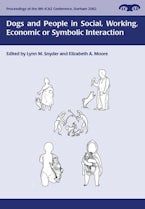This, the final title to be published from the sessions of the 2002 ICAZ conference, focuses on the role of man's best friend. As worker or companion, the dog has enjoyed a unique relationship with its human master, and the depth and variety of the papers in this fascinating collection is a testament to the interest that this symbiotic arrangement holds for many scholars working in archaeology today. The book covers an eclectic range of subjects, such as considering dogs as animals of sacrifice and animal components of ancient and modern religious ritual and practice; dogs as human companions subject to loving care, visual/symbolic representation, deliberate or accidental breed manipulation; as working dogs; and finally as co-inhabitors of uman dwelling paces and co-consumers of human food resources. While many of the papers in this volume have a predominant focus, they also demonstate that the relationships between humans and dogs are rarely, if ever singular or simple. Instead these relationships are complex, often combining the practical, the ideological and the symbolic.
History, ethnography, and archaeology of the Coastal Salish wooly-dog (Russell L Barsh et al); A dwarf hound skeleton from a Romano-British grave at York Road, Leicester (Ian L Baxter); Food, rituals? The exploitation of dogs from Eretria during the Helladic and Hellenistic periods (Isabelle Chenal-Velarde); Artemis Pit? Dog remains from a well in the ancient town of Siracusa (Salvatore Chilardi); In sickness and in health: Care for an arthritic Maltese dog from the Roman cemetery of Yasmina, Carthage (Michael MacKinnon and Kyle Belanger); What did Bronze Age dogs eat? Coprolitic analyses (Liina Maldre); What do dogs mean, what do dogs do? (Michael Atwood Mason); Dog sacrifice in the ancient world: A ritual passage? (Jacopo De Grossi Mazzorin and Claudia Minniti); Bronze Age dogs from graves in Border, The Netherlands and Dimitri, Greece (Wietske Prummel); An ethnoarchaeological study of chase hunting with gundogs by the aboriginal peoples of Taiwan (Atsushi Nobayashi); Variability in medieval dogs from Hungary (Marta Tassi); Companions from the oldest times: Dogs in ancient Greek literature, iconography and osteological testimony (Katerina Trantalidou); Dog-wolf hybrid biotype reconstruction from the archaeological city of Teoihuacan in prehistoric central Mexico (Raúl Valadez et al); The sacrifice of dogs in ancient Italy (Barbara Wilkens); The evidentiary dog: A review of anthrozoological cases and archaeological studies (Bonnie C Yates and Janice Koler-Matznick).

